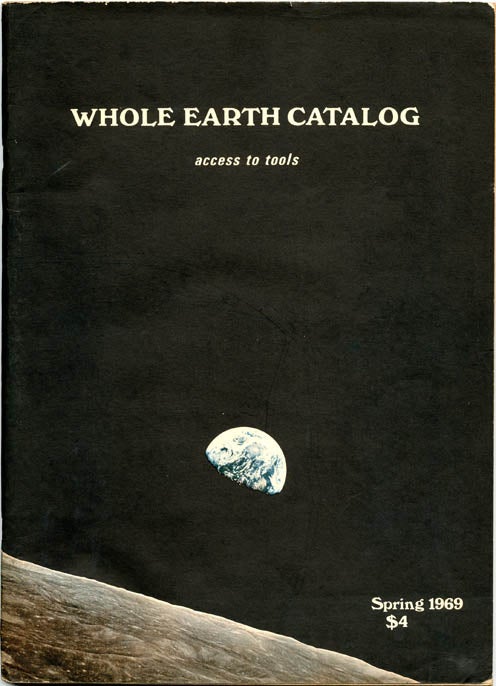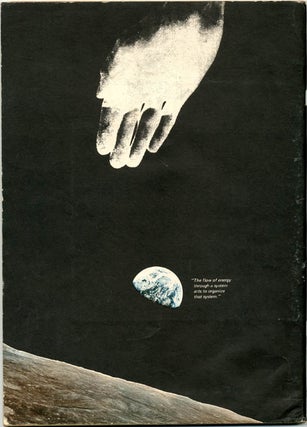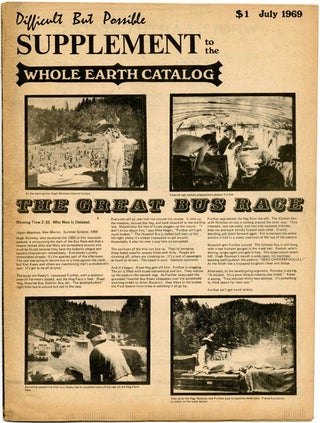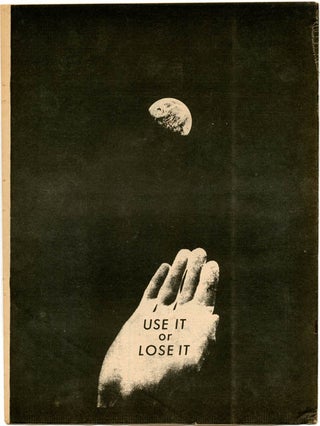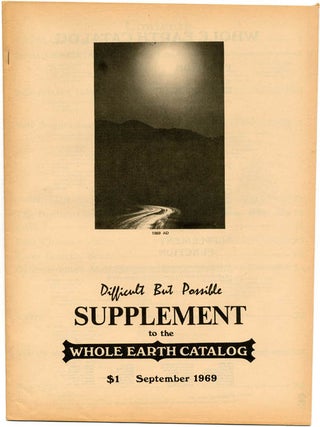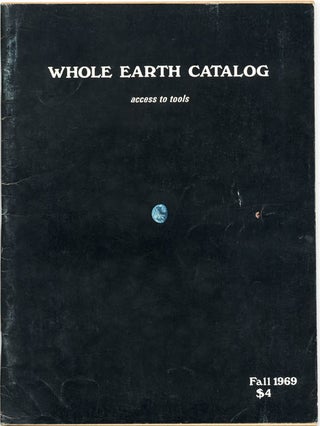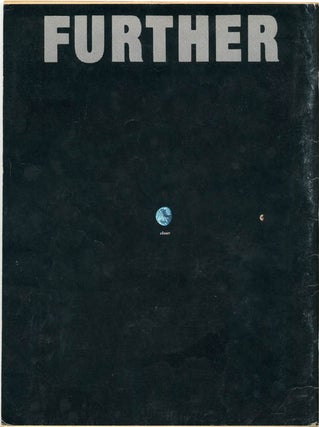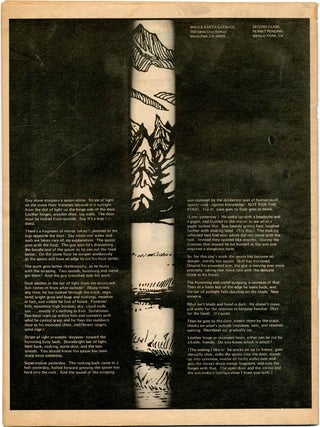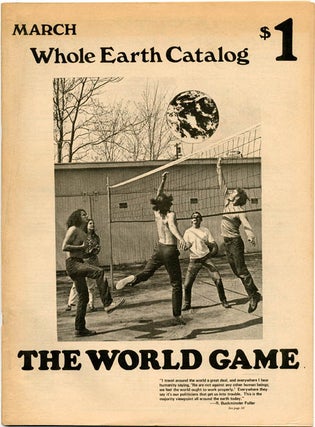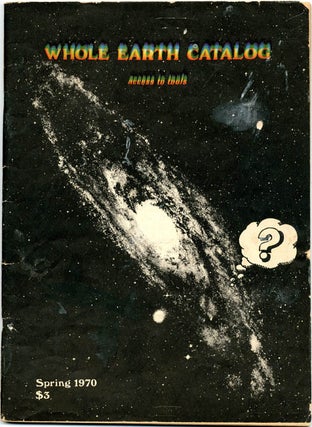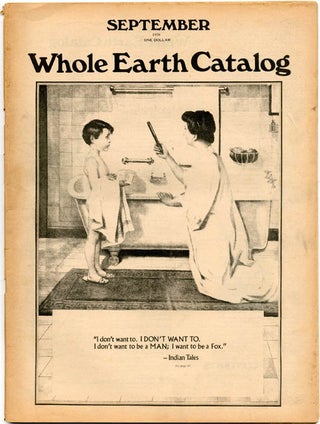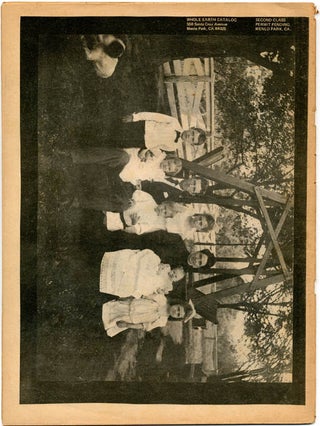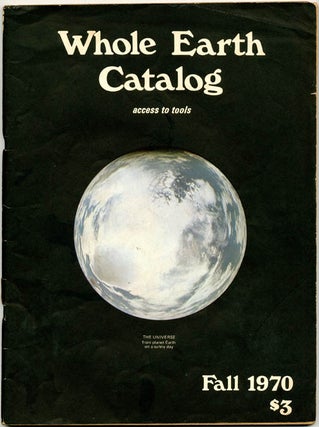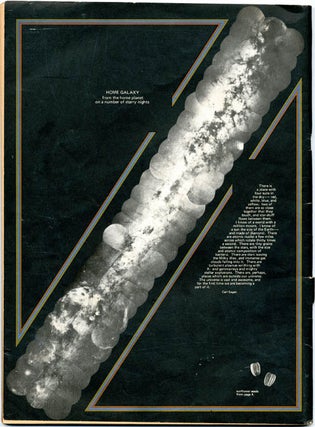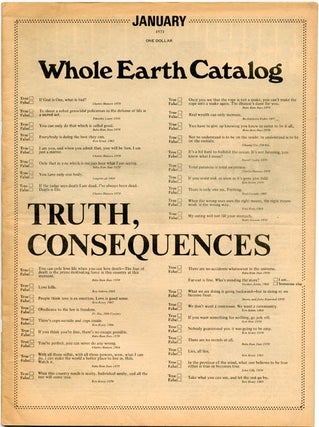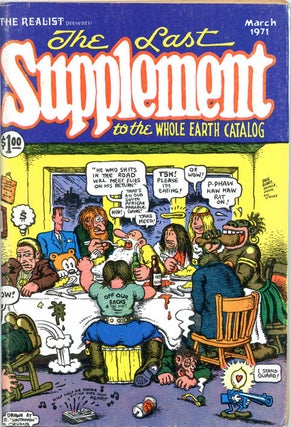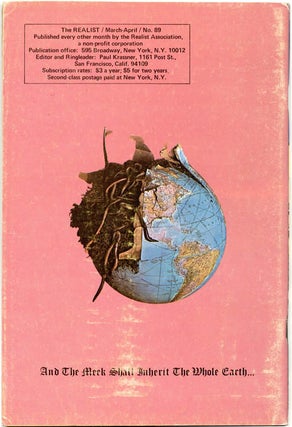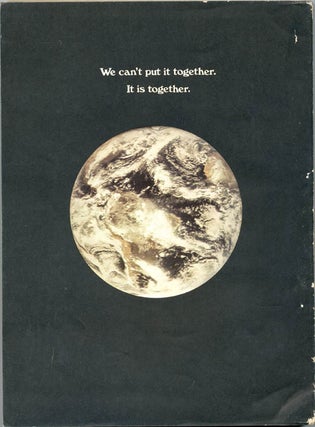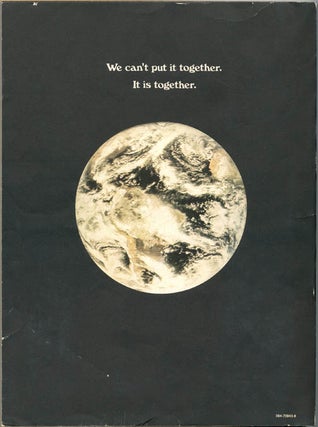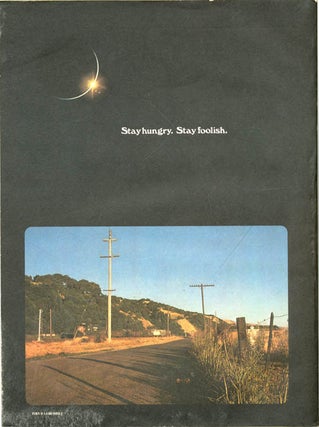31.
WHOLE EARTH CATALOG (Menlo Park, CA: Portola Institute, Spring 1969-October 1974).
Sm. folio, except March 1971 supplement (sm. 4to). Wrps., each 32pp.-452pp. Illustrated throughout. An unbroken run of 15 issues of the Whole Earth Catalog, including supplements, from the second full edition of Spring 1969 through to the Whole Earth Epilog, published in October 1974. Lacks the first edition (September 1968) and its two supplements (January and March 1969).
The Whole Earth Catalog was started by Stewart Brand following his summer 1968 tour of communes across the Southwest with mathematician Lois Jennings. Their Dodge pickup, laden with samples of goods for sale, became known as the Whole Earth Truck Store, and Brand's first Catalog, its cover adorned with a colour photograph of the Earth seen from space, promised 'Access to Tools' and famously asserted that "We are as gods and might as well get good at it." Rather than selling anything directly, he intended it to function as both countercultural toolkit and as a manifesto for alternative lifestyles. He organised it in several sections, most of them rooted in his road trip, including Understanding Whole Systems, Shelter and Land Use, Nomadics, Communication, and Community, each category providing detailed information on how to obtain a vast array of artifacts and merchandise. Influenced by the ideas of Buckminster Fuller, Marshall McLuhan, and cyberneticists Norbert Weiner and Gregory Bateson, Brand arranged the Catalog according to the principles of systems theory, and while it embodied his vision of small-scale technology as a tool for personal liberation and social change, its contents generally eschewed overt politics in favour of do-it-yourself individualism.
Brand began operating as a cultural entrepreneur at the Trips Festival, and his interdisciplinary attempt to connect distinct networks and resources in the Whole Earth Catalog used a similarly holistic approach, epitomised by the geodesic domes designed by Lloyd Kahn and others, a Catalog staple that bridged the gap between science and the counterculture. Computers were not often featured (PCs were still commercially unavailable), but Brand already envisioned them as a potentially revolutionary technology, democratising access to information and communication, and his Whole Earth Catalog, with its densely-packed references and peer-reviewed content, anticipated the hyperlinked World Wide Web that followed two decades later.
i) WHOLE EARTH CATALOG. Spring 1969. 132pp. Ed. Stewart Brand (with Lloyd Kahn). Cover reproduces astronaut Bill Anders' colour photograph of the Earth, taken from the Apollo 8 spacecraft on Christmas Eve 1968 (a satellite photograph of the Earth taken in November 1967 featured on the cover of the first Whole Earth Catalog, an image it later offered for sale as a poster titled 'Mandala Earth'). Notable entries in this issue include Hewlett-Packard's 9100A programmable desktop calculator, suggested by Bob Albrecht of the People's Computer Company, priced at $4900.00 (by the Fall 1969 issue the price had been lowered to $4400.00).
ii) DIFFICULT BUT POSSIBLE SUPPLEMENT TO THE WHOLE EARTH CATALOG. July 1969. 32pp. Ed. Stewart Brand. "The Supplement corrects and updates information in the most recent CATALOG, carries on-going research toward the next CATALOG, and publishes what doesn't fit in the CATALOG but does relate to the use of tools." As well as listing products and providing information on how to obtain them, the Supplements also provided a forum for the Whole Earth Catalog's readers to interact with one another, and gave space for them to describe their personal experiences of the various alternative lifestyles it catered for. Photo-illustrated front cover describes a bus race between Ken Kesey's Further "with a skeleton crew of Farmsters aboard" and buses from "the Hog Farm's fleet: Road Hog, Hospital Bus, Kitchen Bus, etc." Also features a contribution from a member of the Ant Farm collective portraying the 'Cowboy Nomad', a pioneer of the new communalist frontier who is "living in another life style, and waiting for electronic media."
iii) DIFFICULT BUT POSSIBLE SUPPLEMENT TO THE WHOLE EARTH CATALOG. September 1969. 34pp. Ed. Stewart Brand. Includes the first appearance in print of "Four Changes", Gary Snyder's influential ecological manifesto, drawn in part from his discussions with poets, visionaries and activists in the San Francisco Bay area; and "Voices", the transcript of a taped conversation between Jann Wenner, Jordan Belson, Doug Engelbart, Stewart Brand, Victor Moscoso, and Wes Wilson.
iv) WHOLE EARTH CATALOG. Fall 1969. 132pp. Ed. Stewart Brand (with Lloyd Kahn). Cover photographs of the Earth and Moon taken from deep space by recent NASA Apollo missions. The third full issue.
v) WHOLE EARTH CATALOG: THE OUTLAW AREA. January 1970. 56pp. Ed. Stewart Brand. "The $1 Catalog was formerly called the SUPPLEMENT to the Whole Earth Catalog. The name was changed to accommodate the Post Office" (in order to qualify for second class postage). Cover photograph of radio and TV broadcaster, Arthur Godfrey. Includes "The Outlaw Area"; "Liferaft Earth" (Stewart Brand and Hugh Romney's 'happening', a week-long fast designed to make the problem of world hunger and malnutrition a personal matter for participants and observers, documented on film by Robert Frank at their request); "Earth Peoples Park" centrespread; ecology bibliography, with reproduction of Ron Cobb's 'Ecology' poster (item #41); and Baba Ram Dass's booklist, tiled "Whole Consciousness Catalog", a lengthy list of books on Eastern mysticism and consciousness expansion. Also includes a brief section on 'Peradam' (a term coined by René Daumal), "an event held last Autumn Equinox to bring people from technological and long-haired worlds together." Organised by the Augmented Human Intellect Research Center (ARC), together with Stewart Brand and Steve Baer, participants included Zomeworks, Portola Institute, the Pacific High School dome builders, Michael Rossman (of the Parnassus Institute, an alternative education project), Hog Farm, Ecology Center, Curtis Schreier (Ant Farm), and others. Quotes featured in the piece include: "Computers are beginning to give the mechanistic world a brain. And it's our job to give it a soul."
vi) WHOLE EARTH CATALOG: THE WORLD GAME. March 1970. 56pp. Ed. Gurney Norman (with Diana Shugart). Includes Gene Youngblood on "Buckminster Fuller's World Game" (3pp.); the Lama Foundation's "Growhole Basics"; Intrepid Trips Information Service #1, and "Cut The Motherfuckers Loose" by Ken Kesey.
vii) WHOLE EARTH CATALOG. Spring 1970. 148pp. Ed. Stewart Brand (with Lloyd Kahn). Cover photograph of the M-31 Andromeda galaxy, taken by the Lick Observatory, with "question-mark exclamation-mark sequence borrowed with thanks from Robert Crumb." Includes entries for Friends ("the British equivalent of Rolling Stone"), and Mother Earth News (item #43). The fourth full issue. Small losses to top right corner and fore-edge of upper wrapper.
viii) WHOLE EARTH CATALOG: FIND YOUR PLACE IN SPACE. July 1970. 56pp. Edited and designed by Gordon Ashby (a Trips Festival veteran, like Brand, who trained as a designer with Charles and Ray Eames). Contains the Whole Thing Catalog, an 8pp. 'meta-catalogue' devoted to a series of mandala collages accompanied by a text on systems consciousness ("The Earth crisis is your crisis… and mine").
ix) WHOLE EARTH CATALOG. September 1970. 56pp. Ed. Gurney Norman (with Diana Shugart). Includes "Think Little", Wendell Berry's essay about the environmental consequences of human greed and exploitation of the planet (previously published in an underground paper in Kentucky), beginning: "First there was Civil Rights, and then there was the War, and now it is the Environment." Also Stewart Brand's 6pp. annotated "An Indian Bibliography", and "Introducing: Divine Right's Bus, Urge" by Gurney Norman.
x) WHOLE EARTH CATALOG. Fall 1970. 146pp. Ed. JD Smith (manager of the Truck Store in Menlo Park, which sold some of the products in the Catalog), with Hal Hershey. Prints a selection of poems by Gary Snyder. Entries include Steve Baer's 'Zome Primer', with an explanation of the difference between a Zome and a Geodesic Dome; Rags (item #58); Radical Software (item #50); Crazy Comics, featuring a 2pp. spread of underground comic strips by Robert Crumb, Victor Moscoso, and others; Shulamith Firestone's 'The Dialectic of Sex: The Case For Feminist Revolution'; and Lawrence Halprin's 'The RSVP Cycles: The Creative Process in the Human Environment'. The fifth full issue.
xi) WHOLE EARTH CATALOG: TRUTH, CONSEQUENCES. January 1971. 48pp. Ed. Stewart Brand. Includes "Ken Kesey Was A Successful Dope Fiend", an interview with Kesey first printed in the Ann Arbor Argus, then Bitman #2 (item #61), with the final paragraph credited "courtesy of the Compendium Dictation Service: Compendium Bookshops 240 Camden High Street" (London). Also, an extract from a recent lecture by Gregory Bateson. The issue was produced in the desert of California's Saline Valley (west of Death Valley), specifically from inside the Pillow, a giant fifty-by-fifty-foot inflatable created by the Ant Farm collective who had been commissioned by Stewart Brand to create a pneumatic structure as a mobile facility for this edition. Brand's account of the event, titled "Production in the Desert", begins with the epigraph, "Workers of the world, disperse", echoing the Whole Earth Catalog's appeal to the anti-urban, ecologically-minded to disperse into rural or nomadic communal living. A few pencilled annotations; old mailing label to back cover.
xii) THE LAST SUPPLEMENT TO THE WHOLE EARTH CATALOG. March 1971. 132pp. Ed. Paul Krassner and Ken Kesey. Front cover by R. Crumb. Prints several short essays by Kesey - "The Bible"; "The I Ching"; "Mantras"; "Dawgs"; "Filipino Food"; "Tools From My Chest"; and "I've used cornstarch on my balls for years!". Also, "The Dream is Over" by J. Marks (Manson/Altamont); Ed McClanahan on the Grateful Dead/Altamont connection; the Weather Underground; "1989 is Here" (newsletter of Computer People for Peace); 'From Bindu to Ojas' reviewed (item #44); a text on portable video by the Radical Software group; William Burroughs (an extract from 'Nova Express'); Fred Neil; Eldridge Cleaver; Jerome Agel; Neal Cassady; Ron Bevirt; Ken Babbs; Allen Ginsberg; William Hjortsberg. A full-page ad. on the last page prints Stewart Brand's invitation "to all makers of the Whole Earth Catalog… to an Exclusive Party to celebrate the Demise of the Whole Earth Catalog in San Francisco" in June 1971, an event documented in Rolling Stone #86 (item #87).
xiii) THE LAST WHOLE EARTH CATALOG. June 1971. 452pp. Ed. Stewart Brand. Front cover photograph taken from NASA's Apollo 4 spacecraft on November 9, 1967, "probably the first American photograph of the 'whole Earth' "; back cover reproduces "the first full-Earth picture' (previously featured on the front cover of the first Whole Earth Catalog). The sixth full issue, by far the most compendious volume to date (c. 2100 listings), published by the Portola Institute in conjunction with Random House, and the winner in 1972 of the first U.S. National Book Award in category Contemporary Affairs. Lists 'The Architecture Machine' by Nicholas Negroponte (MIT Media Lab) and Jasia Reichart's 'Cybernetic Serendipity' (item #27), and includes a review by Diana Shugart of 'Women and Their Bodies' (retitled 'Our Bodies, Ourselves', item #74) by the Boston Women's Health Collective. In the Communications section, Wendy Carlos writes on synthesizers, including comparisons between the Moog, the Buchla box, and others. On page 112, Stewart Brand describes hippies as "outlaws, dope fiends, and fanatics… with a functional, grimy grasp on the world. World-thinkers, dropouts from specialization. Hope freaks." Surface loss at tail of backstrip, with bump to foot of spine.
xiv) THE UPDATED LAST WHOLE EARTH CATALOG. May 1974. 452pp. Ed. Stewart Brand. Photographs to front and back covers same as previous issue. Incorporates over 3000 changes to The Last Whole Earth Catalog. Tip of lower right front cover missing; small paper loss to edge of p.183; barely perceptible ink ownership name to upper edge of front cover.
xv) WHOLE EARTH EPILOG. September 1974. 320pp. Editor(s) not stated. Front cover photograph of the Earth taken from NASA's Apollo 12 spacecraft; back cover colour photograph of a road "somewhere north of San Francisco Bay". A continuation of The Last Whole Earth Catalog that "does not repeat any of the material in the CATALOG" and "differs from its predecessor primarily in the quality of its research." Regarded by its editors as "a special access-to-tools issue of The CoEvolution Quarterly." Includes the first part of Paul Krassner's satire, 'Tongue Fu', and Jay Baldwin on 'soft' technology (soft was the prefix Stewart Brand preferred to 'alternative' or 'appropriate' - it "signifies something is alive, resilient, adaptive, maybe even loveable."
Except where noted, condition overall is Very Good or better. A near complete run of one of the defining documents of the era, later described by Steve Jobs as "one of the bibles of my generation… It was sort of like Google in paperback form, 35 years before Google came along."
 Back to top
Back to top

